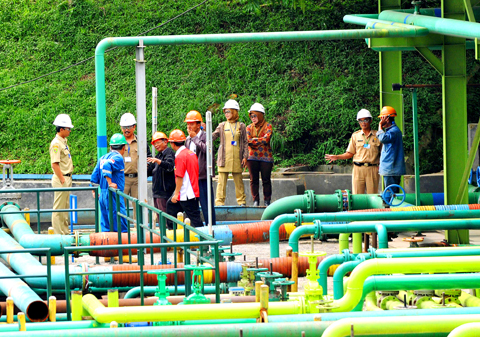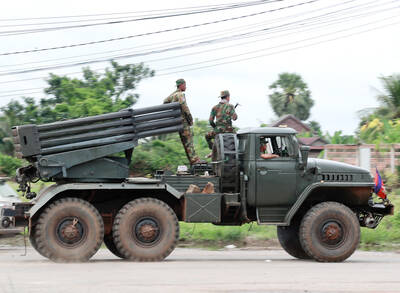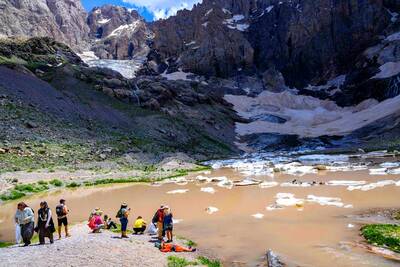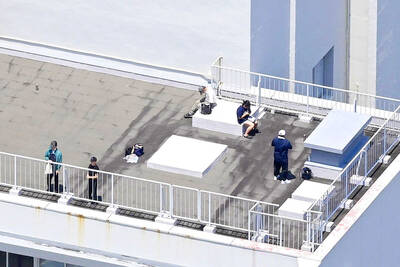Indonesia has launched an ambitious plan to tap the vast power of its volcanoes and become a world leader in geothermal energy, while trimming greenhouse gas emissions.
The sprawling archipelago of 17,000 islands stretching from the Indian to the Pacific oceans contains hundreds of volcanoes, estimated to hold around 40 percent of the world’s geothermal energy potential.
So far, however, only a tiny fraction of that potential has been unlocked, so the government is seeking help from private investors, the World Bank and partners like Japan and the US to exploit the power hidden deep underground.

PHOTO: AFP
“The government’s aim to add 4,000 megawatts [MW] of geothermal capacity from the existing 1,189MW by 2014 is truly challenging,” Indonesian Geothermal Association chief Surya Darma said.
One of the biggest obstacles is the cost. Indonesia currently relies on dirty coal-fired power plants using locally produced coal. A geothermal plant costs about twice as much and can take many more years in research and development to get online.
Once established, however, geothermal plants like the one built in Kamojang, Java, in 1982 can convert the endless free supplies of volcanic heat into electricity with much lower overheads — and less pollution — than coal.
This is the pay-off the government is hoping to sell at the fourth World Geothermal Congress opening today on the Indonesian resort island of Bali. The six-day event will attract some 2,000 people from more than 80 countries.
“An investment of US$12 billion is needed to add 4,000MW capacity,” energy analyst Herman Darnel Ibrahim said, putting into context the recent announcement of US$400 million in financing from lenders including the World Bank and the Asian Development Bank (ADB).
“Field exploration can take from three to five years, suitability studies for funding takes a year, while building the plant itself takes three years,” he added.
If there is any country in the world where geothermal makes sense it is Indonesia. Yet despite its natural advantages, it lags behind the US and the Philippines in geothermal energy production. Southeast Asia’s largest economy and the world’s third biggest greenhouse gas emitter exploits only seven geothermal fields out of more than 250 it could be developing.
The case for geothermal has become stronger with the rapid growth of Indonesia’s economy and the corresponding strain on its creaking power infrastructure.
The archipelago of 234 million people is one of the fastest growing economies in the Group of 20 but currently only 65 percent of Indonesians have access to electricity.
The goal is to reach 90 percent of the population by the end of the decade, through a two-stage plan to “fast-track” the provision of an extra 10,000 MW by 2012, mostly through coal, and another 10,000 MW from clean sources like volcanoes by 2014.
Indonesian President Susilo Bambang Yudhoyono’s pledge to slash greenhouse gas emissions by 26 percent against 2005 levels by 2020 has also spurred the push to geothermal.
Many of the best geothermal sources lie in protected forests, so the government aims to allow the drilling of wells inside conservation areas while insisting that the power plants themselves be outside.
Geothermal fans welcomed the recent completion of negotiations between a consortium of US, Japanese and Indonesian companies and the state electricity company, Perusahaan Listrik Negara, over a 340 MW project on Sumatra island.
The Sarulla project will be Indonesia’s second biggest geothermal plant, after the Wayang Windu facility in West Java.

POLITICAL PATRIARCHS: Recent clashes between Thailand and Cambodia are driven by an escalating feud between rival political families, analysts say The dispute over Thailand and Cambodia’s contested border, which dates back more than a century to disagreements over colonial-era maps, has broken into conflict before. However, the most recent clashes, which erupted on Thursday, have been fueled by another factor: a bitter feud between two powerful political patriarchs. Cambodian Senate President and former prime minister Hun Sen, 72, and former Thai prime minister Thaksin Shinawatra, 76, were once such close friends that they reportedly called one another brothers. Hun Sen has, over the years, supported Thaksin’s family during their long-running power struggle with Thailand’s military. Thaksin and his sister Yingluck stayed

In the sweltering streets of Jakarta, buskers carry towering, hollow puppets and pass around a bucket for donations. Now, they fear becoming outlaws. City authorities said they would crack down on use of the sacred ondel-ondel puppets, which can stand as tall as a truck, and they are drafting legislation to remove what they view as a street nuisance. Performances featuring the puppets — originally used by Jakarta’s Betawi people to ward off evil spirits — would be allowed only at set events. The ban could leave many ondel-ondel buskers in Jakarta jobless. “I am confused and anxious. I fear getting raided or even

Kemal Ozdemir looked up at the bare peaks of Mount Cilo in Turkey’s Kurdish majority southeast. “There were glaciers 10 years ago,” he recalled under a cloudless sky. A mountain guide for 15 years, Ozdemir then turned toward the torrent carrying dozens of blocks of ice below a slope covered with grass and rocks — a sign of glacier loss being exacerbated by global warming. “You can see that there are quite a few pieces of glacier in the water right now ... the reason why the waterfalls flow lushly actually shows us how fast the ice is melting,” he said.

Residents across Japan’s Pacific coast yesterday rushed to higher ground as tsunami warnings following a massive earthquake off Russia’s far east resurfaced painful memories and lessons from the devastating 2011 earthquake and nuclear disaster. Television banners flashed “TSUNAMI! EVACUATE!” and similar warnings as most broadcasters cut regular programming to issue warnings and evacuation orders, as tsunami waves approached Japan’s shores. “Do not be glued to the screen. Evacuate now,” a news presenter at public broadcaster NHK shouted. The warnings resurfaced memories of the March 11, 2011, earthquake, when more than 15,000 people died after a magnitude 9 tremor triggered a massive tsunami that